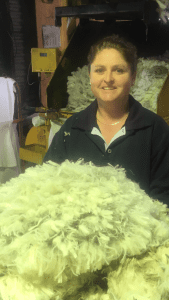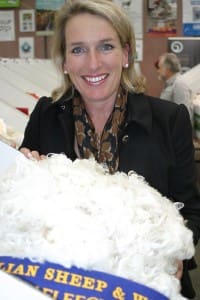
Newstead wool classer Genevieve Butler picked her family’s winning Australian Fleece Competition entry.
A SWITCH to six monthly shearing and some help from their wool-classing daughter has given central Victorian fine wool growers Tony and Debra Butler their first Australian Fleece Competition win.
An 18.3 micron 3-4 year-old Merino ewe fleece from FR Butler & Son, Joyces Park, Newstead, Victoria was judged the champion entry in the Performance Class for exhibitors shearing in six to eight-month cycles commercially.
The Butler’s 3-4 year-old ewe fleece, selected by daughter and KareeWool director Genevieve, was judged the best of 27 entries, scoring well for staple length (71mm), strength (55N/kt), style, colour, evenness and noil to score 93.05 points.
The fleece was shorn on December 16 last year and was estimated to have grown 2.63mm a week, or 115gms/week clean, with a growth value of 217 cents/week.
For the second time in three years, a fleece from Georgina and Hamish Wallace, from the Trefusis Merino Stud in Ross, Tasmania, won the prestigious Grand Champion prize at the Australian Fleece Competition.
Another Tasmanian exhibitor, Roxford Pastoral, took out the Reserve Champion award with a magnificent Polwarth fleece that scored 97 points. It is the first time in competition history that a non-Merino fleece has claimed a major award.
The most valuable commercial fleece in the show was valued at $124.74 and came from Tony Magill of Overland Merino & Poll Merino at Bogan Gate, New South Wales.
Click here to get the latest Sheep Central story links sent to your email inbox.
Six month shearing has advantages
The Australian Fleece Competition is in its 17th year and is the largest fully measured fleece competition in the world, this year attracting almost 420 entries.
Mr Byron said he has been entering the fleece competition since it started and believed it is important to support the commercially-focused event. The family’s 8000-9000 ewe and wether flock had been on a six-month shearing cycle for three years.
“There are extra costs, but we think the management advantages outweigh the cost.
“I’m sure that the sheep join and lamb down better,” he said.
”Overall our flock fertility rate has gone up, but that might be due to better nutrition or a whole lot of factors.”
The shearing is done in May-June and again in December, and lambing is in July-August.
“I think your lambing date should determine when you shear.”
He said there are a number of hidden advantages of twice-yearly that aren’t obvious until it is undertaken for a couple of years.
“The sheep are easier to handle and they do better.”
The Butlers have generally been able to drop a crutching from the Hazeldean blood flock’s program, depending on the season and other factors.
“We also save on fly chemicals over the spring-summer period.”
Mr Butler said the flock generally had no problem achieving sufficient staple length in six months due to its high proportion of younger animals. Older cull ewes are sold joined to White Suffolks. In six months, depending on sheep age and nutrition, staple length can vary from 50-65mm, which has been well-received by the wool’s buyer. Six-monthly has also improved the clip’s tensile strength, he said.
The Butlers use pain relief when mulesing their sheep and has considered stopping mulesing, but believes a premium of $2-$3 a kilogram on wool price would be needed.
“I don’t know who is going to give that to you in the current market.”
But Mr Butler believed a disadvantage of stopping mulesing is the discount which unmulesed surplus sheep attract when sold in saleyards.
“It can be as high as $30-$40 a head for unmulesed sheep – that can be a real hidden trap for people stopping mulesing.”
Tasmanians dominate competition

Georgina Wallace with her top 2015 AFC fleece.
The Trefusis stud’s Grand Champion 17.1 micron fleece scored 97.10 out of a possible 100 points, the highest score in competition history, and helped Georgina and Hamish Wallace win the most successful stud exhibitor award as well.
Georgina Wallace said that she was absolutely thrilled to win the grand champion fleece award in this year’s national competition.
“To win in 2015 was a dream come true, but to be named champion again in a year with so much competition is unbelievable.”
The Tasmanian success continued, with RA McKenzie, “Beltana”, Tasmania, taking out both the champion and reserve champion commercial sections.
Competition judges, Australian Merino Export Company director Chris Kelly, and Landmark Queensland wool account manager, Matthew Thomas, praised the high standard of the entries and said the impeccable preparation and quality of the fleeces was reflected by the record high points achieved.
Mr Thomas praised exhibitors for their high level of presentation, particularly a reduction in skirting, skin pieces and brands from last year.
“The effect of these inferior faults can be detrimental to processing performance, and the points deducted are telling on the overall points of individual fleeces,” Mr Kelly said.
Competition convener, Landmark’s Candice Cordy, said picking the winning entries was always a difficult task for judges, particularly with microns ranging from 11.8 to 47.4.
“Commercial fleeces again comprised 50 percent of entries this year, reinforcing the fact that the fully measured criteria is proving beneficial for growers.
“One of this year’s highlights was the fantastic display of Polwarth and Corriedale entries, as well as a large number of heritage & other breeds including Lincoln and Romney,” Ms Cordy said.
The competition offered $16,000 in prizes, supported by 28 sponsors and more than 200 exhibitors, with the grand champion fleece exhibitor collecting a $2000 travel voucher sponsored by Landmark and WFI Insurance.
The OTIS Foundation, Breast Cancer Retreats, is this year’s nominated charity. Almost two thirds of the fleeces on show were donated by exhibitors for auction at the completion of the competition, with all proceeds to be donated to the foundation.
“A large number of Australians are affected, and The OTIS Foundation helps to ease the burden on those living with breast cancer and their families.
“Over the past 16 years, exhibitors in the Australian Fleece Competition have donated over $125,000 to national charities. The generosity from wool growers and sponsors is overwhelming, and this year’s nominated charity is worthy of our support,” Ms Cordy said.
All competition fleeces were weighed and sampled for objective measurement (including length and strength), under standard procedures of the Australian Wool Testing Authority.
The competition, a joint effort by the Australian Sheep Breeders Association (ASBA), Australian Wool Testing Authority (AWTA) & Landmark, and is run in conjunction with the Australian Sheep and Wool Show in Bendigo July 14-16.
Click here for major Australian Fleece Competition winner details.

HAVE YOUR SAY